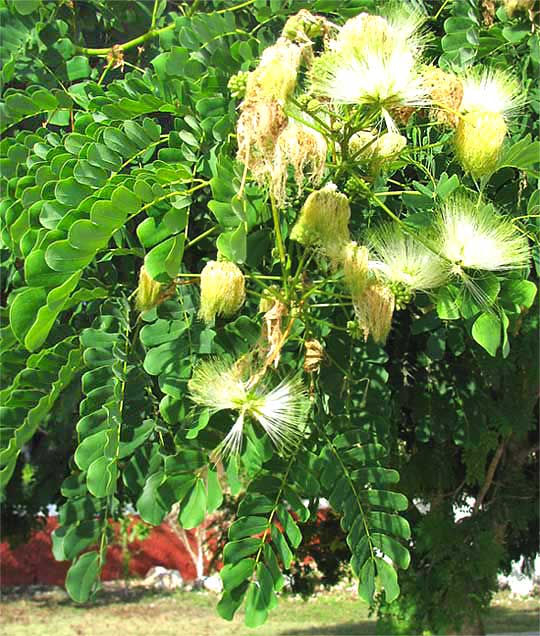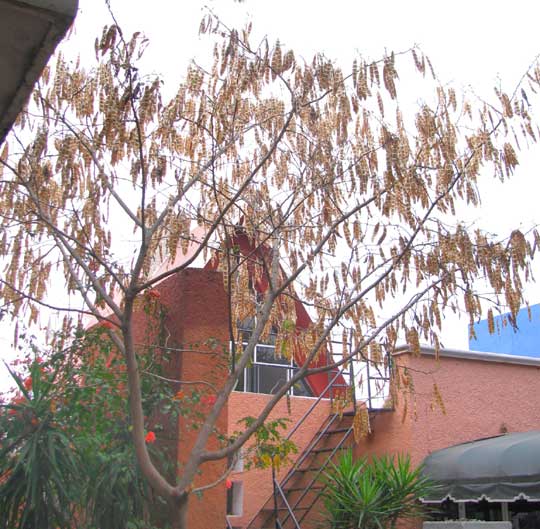Excerpts from Jim Conrad's
Naturalist Newsletter
from the September 8, 2008 Newsletter written in Sabacché, west-central Yucatán, MÉXICO
LEBBECK-TREE FLOWERING
The most graceful, prettiest-flowering street tree in Sabacché right now is the one shown below:

This same species is much planted in Mérida and other Yucatec towns. Northern visitors mostly notice it during the winter/dry season when the trees are loaded with foot-long fruiting pods that dry to a brown, shiny state, and when the wind blows the seeds inside rattle. But, now, it's the fragrant, greenish-yellow, egg-size, powder-puff flower clusters that catch your attention. If you've ever known a woman who'd powder-puff herself with scented talc, you might think of her when you walk by this tree, its honeyed scent pooling in its shadows.
It's the Lebbeck-Tree, ALBIZIA LEBBECK, a native to tropical Asia and northern Australia. The species is planted widely throughout the world's tropics and can grow to 50 feet high (15 m). "Lebbeck" is its Arabic name. I wish I knew how this Asian tree with an Arabic name came to be so common in the Yucatán that even in a little Maya village like Sabacché it occupies an honored spot, shading a good part of the town park. Its shadows provide one of the main firewater-sipping spots for the town's men.
You might recognize the genus name, Albizia, as being the same as that to which North America's much-planted and often invasive Silk-Tree or "Mimosa" belongs to -- that tree being Albizia julibrissin. Silk-Trees produce fuzzy flower clusters like those in the picture, but they're pink. Both species bear twice- pinnately compound leaves, but the Lebbeck-Tree's pinnae are larger and less numerous than the Silk-Tree's, so the feathery effect isn't as conspicuous.
In the flower clusters the slender, fuzzy items are the male parts, the stamens, each one topped by a tiny anther that opens to release pollen. In the picture the stamens in some flower clusters are drooping and turning brown after their blossoms have been pollinated, and the stamens are no longer needed.
How is an Albizia different from an Acacia, which also produces powder-puff-like flower clusters, more than ten male stamens per individual flower, and feathery leaves? In Albizia flowers, the stamens' filament bases are united to one another, while in Acacias, they aren't. Moreover, both Albizia and Acacia differ from the genus Mimosa in that Mimosa blossoms bear ten or fewer stamens. In this area where so many Albizia, Acacia, Mimosa and species of other look-alike genera occur, you just have to memorize these differences, and hope the tree you're wondering about bears flowers!
Whatever the details of its anatomy and taxonomy, the Lebbeck-Tree is one of those beings with such innate dignity and graciousness that you just feel good in its presence.
from the April 18, 2010 Newsletter issued from Hacienda Chichen Resort beside Chichén Itzá Ruins, central Yucatán, MÉXICO; limestone bedrock, elevation ~39m (~128ft), ~N20.676°, ~W88.569°
LEBBECK-TREE'S UGLY TIME
In counterpoint to the Pink Tabebuia's current peak of gorgeousness, another frequently planted street tree in Mérida currently catches your attention because it looks so scruffy. You can see what I mean below:

That's a Lebbeck-Tree, ALBIZIA LEBBECK, completely leafless but absolutely burgeoning with 10-inch-long fruits. Since the mimosa-like genus Albizia is in the Bean Family, the fruits are legumes. A close-up of many dried-out legumes hanging, rattling in the wind, their beans clearly visible within the pods, is below:
